Text
A Comprehensive Guide to Minimally Invasive Heart Valve Surgery
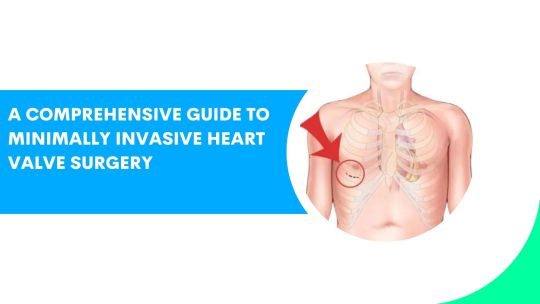
Minimally invasive heart valve surgery has revolutionized the treatment of heart valve diseases, offering patients a less invasive alternative to traditional open-heart surgery. In this comprehensive guide, we will explore the various aspects of minimally invasive heart valve surgery, including the types of procedures, benefits, risks, and recovery.
What is Minimally Invasive Heart Valve Surgery?
Minimally invasive heart valve surgery is a surgical procedure used to repair or replace damaged heart valves through small incisions in the chest, rather than through a large incision in the breastbone. This approach reduces trauma to the chest wall and muscles, resulting in less pain and a faster recovery time compared to traditional open-heart surgery.
Types of Minimally Invasive Heart Valve Surgery
There are several types of minimally invasive heart valve surgery, including:
Minimally Invasive Valve Repair: This procedure is used to repair a damaged heart valve without removing it. The surgeon accesses the heart through small incisions and uses specialized instruments to repair the valve.
Minimally Invasive Valve Replacement: In this procedure, a damaged heart valve is replaced with a mechanical or biological valve. The surgeon accesses the heart through small incisions and removes the damaged valve before replacing it with the new valve.
Transcatheter Valve Replacement (TAVR): TAVR is a minimally invasive procedure used to replace a damaged aortic valve. The new valve is delivered to the heart through a catheter inserted into the blood vessels, usually in the groin or chest.
Benefits of Minimally Invasive Heart Valve Surgery
Minimally invasive heart valve surgery offers several key benefits over traditional open-heart surgery, including:
Faster Recovery: Patients undergoing minimally invasive surgery typically experience a faster recovery time and can return to normal activities sooner.
Less Pain: Smaller incisions result in less trauma to the chest wall and muscles, leading to less postoperative pain.
Smaller Scars: The smaller incisions used in minimally invasive surgery result in smaller scars compared to traditional open-heart surgery.
Reduced Risk of Infection: Minimally invasive surgery reduces the risk of postoperative infections due to smaller incisions and less tissue trauma.
Risks of Minimally Invasive Heart Valve Surgery
While minimally invasive heart valve surgery is generally safe, there are some risks associated with the procedure, including:
Bleeding: There is a risk of bleeding during or after the surgery, which may require blood transfusions.
Infection: Although the risk of infection is lower with minimally invasive surgery, it can still occur.
Damage to Surrounding Organs: There is a slight risk of damage to surrounding organs, such as the lungs or esophagus, during the surgery.
Recovery from Minimally Invasive Heart Valve Surgery
Recovery from minimally invasive heart valve surgery is typically faster than recovery from traditional open-heart surgery. Most patients are able to return to normal activities within a few weeks, although strenuous activities should be avoided for a longer period. Patients may also be prescribed medications to help with pain management and prevent blood clots.
In conclusion, minimally invasive heart valve surgery offers patients a safe and effective treatment option for heart valve diseases. With its shorter recovery time, smaller scars, and reduced risk of complications, it is a preferred choice for many patients and surgeons alike.
Source:- https://www.micsheart.com/minimally-invasive-heart-valve-surgery/
0 notes
Text
Advancements in Minimally Invasive Bypass Surgery Techniques

Minimally invasive bypass surgery techniques have revolutionized the field of cardiovascular surgery, offering patients a safer and more effective alternative to traditional open-heart surgery. These techniques, also known as minimally invasive coronary artery bypass grafting (CABG), utilize smaller incisions, specialized instruments, and advanced imaging technologies to access and repair blocked or damaged coronary arteries. In this article, we explore the latest advancements in minimally invasive bypass surgery techniques, highlighting their benefits and outcomes.
Evolution of Minimally Invasive Bypass Surgery
Minimally invasive bypass surgery techniques have evolved significantly over the past few decades, driven by advancements in surgical technology and techniques. The first minimally invasive CABG procedures were performed in the 1990s and involved small incisions, specialized endoscopic cameras, and robotic-assisted surgical instruments. These early procedures were primarily used for selected patients with single-vessel disease and offered reduced pain, shorter hospital stays, and faster recovery times compared to traditional open-heart surgery.
Current Techniques and Technologies
Today, minimally invasive bypass surgery techniques have expanded to include a range of procedures, such as robotic-assisted CABG, off-pump CABG, and hybrid CABG procedures. These techniques utilize advanced imaging technologies, such as intraoperative angiography and 3D mapping, to precisely identify and repair blocked or damaged coronary arteries. Robotic-assisted CABG, for example, uses robotic arms controlled by the surgeon to perform intricate bypass grafting with unparalleled precision and dexterity.
Benefits of Minimally Invasive Bypass Surgery
Minimally invasive bypass surgery offers several key benefits over traditional open-heart surgery, including:
Smaller Incisions: Minimally invasive techniques require smaller incisions, resulting in less trauma to the surrounding tissues and reduced scarring.
Faster Recovery: Patients undergoing minimally invasive bypass surgery typically experience faster recovery times and can return to normal activities sooner.
Reduced Risk of Infection: Smaller incisions and reduced tissue trauma lead to a lower risk of postoperative infections.
Improved Cosmesis: Minimally invasive techniques result in less visible scarring, improving the cosmetic outcomes for patients.
Outcomes and Success Rates
Studies have shown that minimally invasive bypass surgery techniques offer comparable outcomes to traditional open-heart surgery in terms of graft patency rates, long-term survival, and freedom from angina. Patients undergoing minimally invasive CABG also report higher satisfaction rates and improved quality of life compared to those undergoing traditional surgery. Additionally, the risk of stroke and other complications is generally lower with minimally invasive techniques, making them a preferred choice for many patients and surgeons alike.
Conclusion
Advancements in minimally invasive bypass surgery techniques have transformed the field of cardiovascular surgery, offering patients a safer, more effective, and less invasive alternative to traditional open-heart surgery. These techniques, coupled with advanced imaging technologies and robotic-assisted surgical systems, have significantly improved patient outcomes and quality of life. As technology continues to advance, we can expect further refinements in minimally invasive bypass surgery techniques, leading to even better outcomes for patients with coronary artery disease.
Source:- https://www.micsheart.com/minimally-invasive-bypass-surgery/
0 notes
Text
Understanding the Risks and Success Rates of Minimally Invasive Heart Surgery

Minimally invasive heart surgery has revolutionized the field of cardiac surgery, offering patients a less invasive alternative to traditional open-heart procedures. While this approach has many benefits, it is essential to understand the risks and success rates associated with minimally invasive heart surgery to make informed decisions about treatment options.
What is Minimally Invasive Heart Surgery?
Minimally invasive heart surgery is a surgical technique that uses small incisions and specialized instruments to perform heart procedures. This approach allows surgeons to access the heart without the need for a large incision in the chest, as is required in traditional open-heart surgery.
Risks Associated with Minimally Invasive Heart Surgery
While minimally invasive heart surgery is generally safe, like any surgical procedure, it carries certain risks. Some of the potential risks associated with minimally invasive heart surgery include:
Bleeding: There is a risk of bleeding at the surgical site, although this is usually minimal.
Infection: As with any surgery, there is a risk of infection, which can typically be managed with antibiotics.
Damage to Surrounding Tissues: There is a small risk of damage to surrounding tissues or organs during the surgery.
Blood Clots: There is a risk of blood clots forming, which can lead to complications such as stroke or heart attack.
Success Rates of Minimally Invasive Heart Surgery
Minimally invasive heart surgery has been shown to have success rates comparable to traditional open-heart surgery for many procedures. Success rates can vary depending on the specific procedure being performed and the skill and experience of the surgical team. However, overall, minimally invasive heart surgery has a high success rate and is associated with excellent outcomes for many patients.
Advantages of Minimally Invasive Heart Surgery
Minimally invasive heart surgery offers several advantages over traditional open-heart surgery, including:
Smaller Incisions: Minimally invasive surgery requires smaller incisions, resulting in less pain and scarring.
Shorter Recovery Time: Patients undergoing minimally invasive surgery often experience a quicker recovery time and can return to normal activities sooner.
Reduced Risk of Infection: The smaller incisions used in minimally invasive surgery reduce the risk of infection compared to traditional open-heart surgery.
Improved Cosmetic Results: The smaller incisions result in less noticeable scarring, leading to improved cosmetic results.
Conclusion
Minimally invasive heart surgery is a safe and effective alternative to traditional open-heart surgery for many patients. While it carries certain risks, the success rates of minimally invasive heart surgery are high, and the benefits often outweigh the potential risks. By understanding the risks and success rates associated with minimally invasive heart surgery, patients can make informed decisions about their treatment options.
Source:- https://www.micsheart.com/minimally-invasive-heart-surgery-advantages-disadvantages/
0 notes
Text
Enhancing Patient Outcomes: An In-depth Analysis of Minimally Invasive Mitral Valve Surgery

Minimally invasive mitral valve surgery has emerged as a groundbreaking approach to treating mitral valve disease, offering patients a less invasive alternative to traditional open-heart surgery. This article provides a comprehensive analysis of the benefits and outcomes associated with this innovative procedure.
Understanding Mitral Valve Disease
Mitral valve disease occurs when the mitral valve, which regulates blood flow between the heart’s left atrium and left ventricle, malfunctions. This can lead to symptoms such as shortness of breath, fatigue, and heart palpitations. Traditionally, mitral valve disease has been treated with open-heart surgery, which involves a large incision in the chest and significant recovery time.
The Evolution of Minimally Invasive Surgery
Minimally invasive mitral valve surgery represents a significant advancement in the field of cardiac surgery. Instead of a large incision, this approach uses several small incisions, typically between the ribs, to access the heart. Specialized instruments and a small camera are inserted through these incisions, allowing the surgeon to repair or replace the mitral valve.
Benefits of Minimally Invasive Surgery
Minimally invasive mitral valve surgery offers several advantages over traditional open-heart surgery:
Smaller Incisions: Minimally invasive surgery requires smaller incisions, resulting in less pain, reduced risk of infection, and faster recovery times.
Shorter Hospital Stay: Patients undergoing minimally invasive surgery often spend less time in the hospital compared to those undergoing traditional surgery.
Quicker Recovery: Patients can return to normal activities sooner after minimally invasive surgery, leading to improved quality of life.
Comparable Outcomes: Studies have shown that the outcomes of minimally invasive mitral valve surgery are comparable to those of traditional open-heart surgery in terms of long-term survival and valve function.
Advanced Techniques and Technologies
Advancements in surgical techniques and technologies have further enhanced the outcomes of minimally invasive mitral valve surgery. For example, the use of robotic-assisted surgery allows for greater precision and control during the procedure, resulting in improved outcomes for patients.
Patient Selection and Outcomes
Patient selection is crucial for determining the success of minimally invasive mitral valve surgery. Candidates for this procedure are typically those with isolated mitral valve disease who are otherwise healthy. Studies have shown that in appropriately selected patients, minimally invasive mitral valve surgery can achieve excellent outcomes with low rates of complications.
Conclusion
In conclusion, minimally invasive mitral valve surgery represents a significant advancement in the field of cardiac surgery, offering patients a less invasive alternative to traditional open-heart surgery. With its numerous benefits and comparable outcomes, this innovative procedure has the potential to enhance patient outcomes and improve quality of life for individuals with mitral valve disease.
Source:- https://www.micsheart.com/article/minimally-invasive-mitral-valve-repair/
0 notes
Text
The Advantages of Minimally Invasive Aortic Valve Replacement

Minimally invasive aortic valve replacement (MIAVR) is a surgical procedure used to replace a damaged or diseased aortic valve with a prosthetic valve. Unlike traditional open-heart surgery, which requires a large incision in the chest, MIAVR is performed through small incisions in the chest, typically between the ribs. This approach offers several advantages over traditional surgery, including:
1. Reduced Trauma and Faster Recovery
MIAVR is less invasive than traditional surgery, which means less trauma to the surrounding tissues and organs. This results in less pain, reduced risk of infection, and a faster recovery time for the patient. Patients undergoing MIAVR typically spend less time in the hospital and are able to return to their normal activities sooner than those undergoing traditional surgery.
2. Smaller Incisions and Better Cosmesis
The small incisions used in MIAVR result in better cosmesis, as they are less noticeable than the large incision used in traditional surgery. This can lead to improved patient satisfaction and self-esteem.
3. Reduced Blood Loss and Transfusion Rates
MIAVR is associated with reduced blood loss during surgery, which can lead to a lower need for blood transfusions. This is particularly beneficial for patients who may not be able to tolerate a large blood loss, such as elderly patients or those with underlying medical conditions.
4. Comparable Outcomes to Traditional Surgery
Studies have shown that MIAVR produces outcomes comparable to traditional surgery in terms of valve function and long-term survival rates. This means that patients undergoing MIAVR can expect similar outcomes to those undergoing traditional surgery, with the added benefits of a less invasive approach.
5. Potential for Earlier Intervention
The less invasive nature of MIAVR may allow for earlier intervention in patients with aortic valve disease. This can lead to better outcomes, as earlier treatment may prevent the progression of the disease and reduce the risk of complications.
In conclusion, minimally invasive aortic valve replacement offers several advantages over traditional open-heart surgery, including reduced trauma, faster recovery, better cosmesis, and comparable outcomes. It is a safe and effective treatment option for patients with aortic valve disease and is associated with high patient satisfaction rates.
Source:- https://www.micsheart.com/minimally-invasive-bypass-surgery/
0 notes
Text
Robotic Mitral Valve Repair
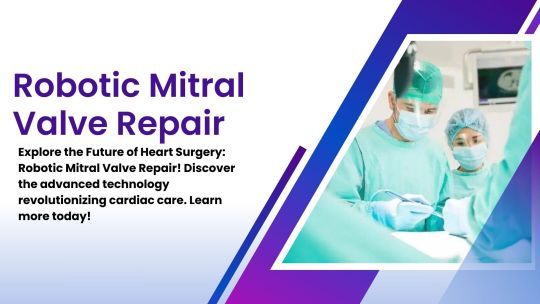
Robotic mitral valve repair represents a paradigm shift in the field of cardiac surgery, offering patients a minimally invasive approach to treat mitral valve diseases with unparalleled precision and efficacy. This innovative technique, leveraging state-of-the-art robotic technology, has transformed the landscape of cardiac care, providing patients with improved outcomes, reduced recovery times, and enhanced quality of life. Let’s delve into the intricacies of robotic mitral valve repair and explore its remarkable benefits in revolutionizing cardiac interventions.
Understanding Mitral Valve Disease
The mitral valve, located between the left atrium and left ventricle of the heart, plays a crucial role in regulating blood flow during each cardiac cycle. Mitral valve diseases, including mitral regurgitation and mitral valve prolapse, can impede the valve’s function, leading to symptoms such as shortness of breath, fatigue, and palpitations. Traditionally, mitral valve repair or replacement surgery involved open-heart procedures, which necessitated large incisions, prolonged hospital stays, and extended recovery periods.
The Advent of Robotic Mitral Valve Repair
Robotic-assisted mitral valve repair represents a groundbreaking advancement in cardiac surgery, offering a less invasive alternative to traditional open-heart procedures. This cutting-edge technique utilizes miniature robotic arms controlled by skilled surgeons via a console, enabling precise manipulation and suturing within the confined space of the heart. By accessing the mitral valve through small incisions between the ribs, robotic surgery minimizes trauma to surrounding tissues, reduces postoperative pain, and accelerates healing.
Key Advantages of Robotic Mitral Valve Repair
Minimally Invasive Approach: Robotic surgery allows surgeons to perform intricate mitral valve repairs through small incisions, minimizing trauma to the chest wall and reducing the risk of complications associated with traditional open-heart surgery.
Enhanced Visualization: High-definition 3D imaging systems provide surgeons with unparalleled visualization of the mitral valve anatomy, enabling precise assessment and meticulous repair of valve abnormalities with greater accuracy and confidence.
Improved Patient Outcomes: Studies have demonstrated that patients undergoing robotic mitral valve repair experience shorter hospital stays, faster recovery times, and superior clinical outcomes compared to those undergoing traditional open-heart procedures.
Preservation of Tissue and Function: Unlike valve replacement surgeries, which involve the removal of the native valve and implantation of prosthetic devices, robotic repair techniques aim to preserve the patient’s own valve tissue and function whenever possible, reducing the need for lifelong anticoagulation therapy and minimizing the risk of complications.
Clinical Applications and Future Directions
Robotic mitral valve repair has broadened the scope of surgical interventions for mitral valve diseases, offering new hope to patients who may not be candidates for traditional open-heart procedures. With ongoing advancements in robotic technology, including the development of enhanced imaging modalities, intuitive surgical platforms, and robotic instruments, the future holds tremendous promise for further refining and expanding the applications of robotic-assisted cardiac surgery.
Conclusion
Robotic mitral valve repair stands at the forefront of innovation in cardiac surgery, reshaping the treatment landscape for patients with mitral valve diseases. By combining precision, efficiency, and minimally invasive techniques, robotic surgery offers a transformative approach to mitral valve repair, improving patient outcomes and enhancing quality of life. As technology continues to evolve, robotic-assisted cardiac interventions will continue to revolutionize the field of cardiovascular medicine, ushering in a new era of personalized, patient-centered care.
Source:- https://www.micsheart.com/robotic-mitral-valve-repair/
0 notes
Text
Minimally Invasive Heart Surgery: Advantages & Disadvantages
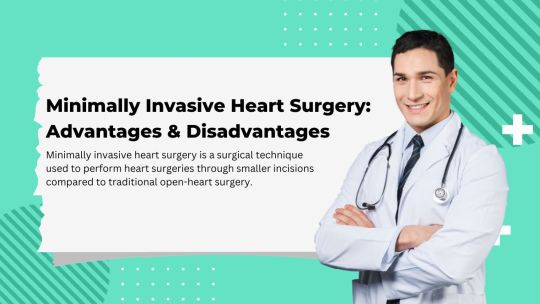
In the realm of cardiovascular health, minimally invasive heart surgery has emerged as a groundbreaking approach that captivates both patients and medical professionals alike. This revolutionary technique, often referred to as keyhole surgery, involves smaller incisions compared to traditional open-heart surgery, promising quicker recovery times and reduced trauma. Let's delve into the intricacies of this surgical marvel and explore the nuanced advantages and disadvantages it brings to the forefront.
Advantages of Minimally Invasive Heart Surgery
1. Reduced Scarring and Faster Recovery
One of the paramount advantages of minimally invasive heart surgery is the significantly reduced scarring associated with smaller incisions. Unlike conventional open-heart procedures that leave large scars, this approach promotes a more aesthetically pleasing outcome. Additionally, the smaller incisions contribute to faster recovery times, allowing patients to resume their normal activities swiftly.
2. Shortened Hospital Stay
Patients undergoing minimally invasive heart surgery often experience shorter hospital stays compared to those opting for traditional methods. The streamlined process and quicker recovery enable individuals to return home sooner, fostering a more comfortable and conducive environment for recuperation.
3. Lower Risk of Infections and Complications
With smaller incisions, the risk of infections and complications decreases significantly. The minimized exposure of internal organs reduces the likelihood of postoperative infections, ensuring a smoother and safer recovery period for patients undergoing minimally invasive heart surgery.
4. Enhanced Cosmetic Outcome
In addition to the physical health benefits, this innovative surgical technique offers an improved cosmetic outcome. Patients appreciate the subtler scarring, contributing to higher satisfaction levels and increased confidence in their appearance post-surgery.
Disadvantages of Minimally Invasive Heart Surgery
1. Limited Visibility and Access
While minimally invasive heart surgery boasts many advantages, it comes with inherent challenges, such as limited visibility and restricted access for surgeons. The smaller incisions may hinder the surgeon's ability to navigate and manipulate certain areas effectively, potentially leading to complications during the procedure.
2. Technical Complexity
Performing minimally invasive heart surgery requires advanced technical skills and proficiency. Surgeons must navigate the intricacies of specialized instruments and video-assisted technologies, adding an element of complexity to the procedure. This complexity may pose challenges in certain cases, requiring a highly skilled surgical team.
3. Equipment Costs
The adoption of minimally invasive heart surgery involves the use of specialized equipment and advanced technology, contributing to higher procedural costs. While the long-term benefits may outweigh these initial expenses, it's crucial to consider the financial implications associated with the investment in cutting-edge surgical tools.
4. Learning Curve for Surgeons
For surgeons transitioning from traditional open-heart procedures to minimally invasive techniques, there exists a learning curve. Acquiring the necessary skills and expertise to perform these surgeries optimally may take time, potentially impacting the success rates in the early stages of adoption.
Conclusion
In the ever-evolving landscape of cardiac care, minimally invasive heart surgery stands as a beacon of progress, offering a plethora of advantages coupled with nuanced challenges. Patients and healthcare professionals must weigh the pros and cons carefully, considering individual health profiles and preferences. As technology advances and surgeons refine their skills, the landscape of cardiac surgery continues to transform, promising better outcomes for those seeking innovative solutions to heart-related issues.
Source:- https://www.micsheart.com/minimally-invasive-heart-surgery-advantages-disadvantages/
0 notes
Text
Minimally Invasive Valve Replacement: A Revolutionary Approach to Heart Valve Surgery
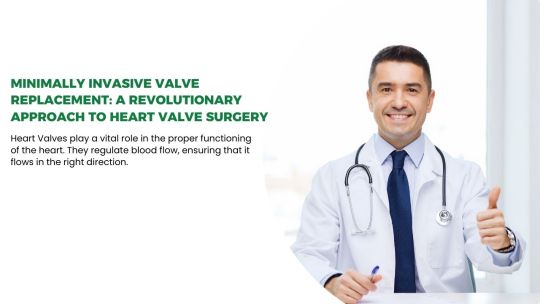
In the realm of cardiovascular health, the landscape of treatment options has evolved significantly over the years. One groundbreaking advancement that has gained substantial attention is Minimally Invasive Valve Replacement, an innovative and less invasive approach to heart valve surgery.
Understanding Minimally Invasive Heart Surgery
What Sets Minimally Invasive Valve Replacement Apart?
Minimally Invasive Valve Replacement stands out as a cutting-edge alternative to traditional heart valve surgery. Unlike conventional procedures that involve a large incision through the breastbone (sternotomy), minimally invasive techniques utilize smaller incisions, often between the ribs. This approach minimizes trauma to surrounding tissues and muscles, leading to a more efficient and expedited recovery process for patients.
The Surgical Procedure Unveiled
1. Small Incisions, Big Impact
The primary hallmark of Minimally Invasive Valve Replacement is the use of small incisions, typically ranging from 2 to 4 inches. Through these incisions, surgeons gain access to the heart without the need for a sternotomy. This not only reduces the risk of infection but also accelerates healing times.
2. Advanced Imaging Guidance
Another pivotal aspect is the integration of advanced imaging technologies during surgery. Surgeons leverage tools like echocardiography and fluoroscopy for real-time visualization, ensuring precise placement of the new valve. This level of accuracy contributes to improved outcomes and reduced complications.
The Benefits of Minimally Invasive Valve Replacement
1. Faster Recovery
Due to the smaller incisions and decreased trauma to surrounding tissues, patients undergoing Minimally Invasive Valve Replacement experience a remarkably faster recovery compared to traditional surgery. This means a quicker return to normal daily activities and a reduced hospital stay.
2. Reduced Scarring
Smaller incisions translate to minimal scarring, offering both physical and emotional relief to patients. The cosmetic aspect of Minimally Invasive Valve Replacement adds an extra layer of appeal for individuals concerned about the aesthetic repercussions of surgery.
3. Lower Risk of Infection
The reduced exposure of internal organs during surgery significantly lowers the risk of postoperative infections. This makes Minimally Invasive Valve Replacement an attractive option for individuals with a heightened susceptibility to infections or other complications.
Choosing Minimally Invasive Valve Replacement: A Wise Decision
Patient Considerations
1. Individualized Treatment Plans
The versatility of Minimally Invasive Valve Replacement allows for personalized treatment plans tailored to each patient’s unique anatomy and health circumstances. This individualized approach enhances the overall effectiveness of the procedure.
2. Applicability Across Age Groups
Contrary to misconceptions, Minimally Invasive Valve Replacement is not exclusive to a particular age group. It has proven successful in a diverse range of patients, including the elderly and those with underlying health conditions.
Surgeon’s Perspective
1. Enhanced Precision and Control
From a surgeon’s perspective, the smaller incisions and advanced imaging technologies provide enhanced precision and control during the procedure. This translates to a more streamlined surgery with fewer complications.
2. Continuous Advancements
The field of Minimally Invasive Valve Replacement is continually evolving, with ongoing research and technological advancements enhancing the procedure’s safety and efficacy. Surgeons embracing these innovations stay at the forefront of cardiovascular care.
Conclusion
In the ever-evolving landscape of cardiovascular medicine, Minimally Invasive Valve Replacement emerges as a beacon of progress. Its less invasive nature, coupled with the myriad benefits for both patients and surgeons, positions it as a frontrunner in the realm of heart valve surgery.
Source:- https://www.micsheart.com/minimally-invasive-valve-replacement/
0 notes
Text
Robotic heart surgery — What you should know and what you should ask | MICS Heart
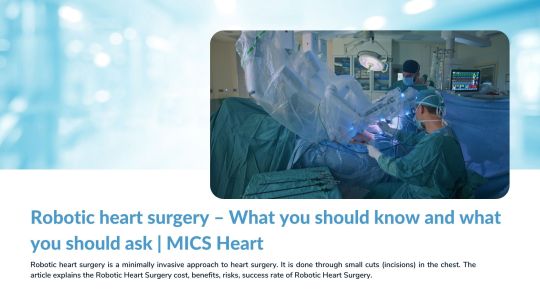
In recent years, robotic heart surgery has emerged as a groundbreaking technological advancement in the field of cardiac care. As pioneers in the medical landscape continually push the boundaries of innovation, Minimally Invasive Cardiac Surgery (MICS) has become synonymous with precision and enhanced patient outcomes. In this comprehensive guide, we delve into what you should know and the crucial questions you should ask when considering robotic heart surgery.
Understanding the Essence of Robotic Heart Surgery
Robotic heart surgery is a minimally invasive procedure that utilizes cutting-edge robotic systems to perform intricate cardiac interventions with unparalleled precision. Unlike traditional open-heart surgeries, MICS involves smaller incisions, reduced trauma to surrounding tissues, and a faster recovery period for patients.
The MICS Advantage
1. Precision in Procedure
One of the paramount advantages of robotic heart surgery is the exceptional precision it offers. The robotic arms, controlled by skilled surgeons, can navigate with utmost accuracy, allowing for intricate maneuvers that were once deemed impossible.
2. Minimized Trauma
The smaller incisions employed in MICS contribute to a significant reduction in trauma to the chest wall and surrounding tissues. This results in less postoperative pain, shorter hospital stays, and an accelerated return to normal activities for patients.
3. Enhanced Visualization
Robotic systems provide surgeons with high-definition, 3D visualization of the operative field. This heightened clarity enables a meticulous examination of the cardiac structures, ensuring comprehensive and effective interventions.
Key Considerations When Opting for MICS Heart Surgery
1. Surgeon Expertise
Selecting a surgeon with extensive experience in robotic heart surgery is paramount. Ensure that your chosen healthcare professional is not only certified in MICS procedures but also possesses a track record of successful outcomes.
2. Patient Eligibility
While MICS is a versatile approach, not every patient is a suitable candidate. Factors such as the complexity of the cardiac condition, previous surgeries, and overall health must be thoroughly assessed by the medical team.
3. Benefits and Risks
Before undergoing robotic heart surgery, it is crucial to have a clear understanding of the potential benefits and associated risks. Discuss these aspects in detail with your healthcare provider to make an informed decision.
4. Recovery Expectations
Robotic heart surgery typically offers a swifter recovery compared to traditional procedures. However, individual recovery times may vary. Discuss the anticipated recovery period, postoperative care, and any lifestyle adjustments with your medical team.
Questions to Ask Your Healthcare Provider
1. What is Your Experience with Robotic Heart Surgery?
Inquire about the surgeon’s expertise in MICS procedures, including the number of surgeries performed and their success rates.
2. Am I a Suitable Candidate for Robotic Heart Surgery?
Discuss your specific medical history and cardiac condition to determine if you are a candidate for MICS.
3. What are the Expected Benefits in My Case?
Seek a detailed explanation of how robotic heart surgery can specifically benefit your cardiac health, considering your unique circumstances.
4. What Risks Should I be Aware Of?
Understanding the potential risks associated with the procedure is crucial for making an informed decision. Ensure your healthcare provider provides a comprehensive overview.
Conclusion: Empowering Patients Through Informed Choices
As the realm of robotic heart surgery continues to evolve, patients are presented with a transformative option for cardiac interventions. Armed with the knowledge of the procedure’s advantages, key considerations, and pertinent questions to ask, individuals can make informed decisions about their cardiac care.
Source: https://www.micsheart.com/article/robotic-cardiac-surgery-benefits-risks-cost-and-success-rate/
0 notes
Text

Experience advanced cardiac care with Minimally Invasive Mitral Valve Repair (MICS HEART). Our cutting-edge approach ensures precision and faster recovery, minimizing incisions for optimal patient outcomes. Trust us for expert, compassionate care that prioritizes your heart health. Choose MICS HEART for a minimally invasive solution to mitral valve issues.
Visit:- https://www.micsheart.com/article/minimally-invasive-mitral-valve-repair/
0 notes
Text
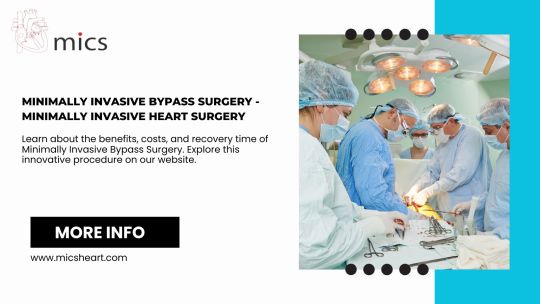
Discover the future of cardiac care with our Minimally Invasive Bypass Surgery. Our expert team specialises in cutting-edge Minimally Invasive Heart Surgery, ensuring reduced trauma, quicker recovery, and minimal scarring. Experience the benefits of precision and innovation as we restore your heart's health. Choose the path of least intrusion with our advanced techniques. Your heart deserves the best – contact us today for a consultation and embark on your journey to a healthier, happier life.
Visit:- https://www.micsheart.com/minimally-invasive-bypass-surgery/
1 note
·
View note